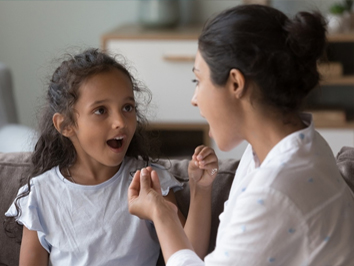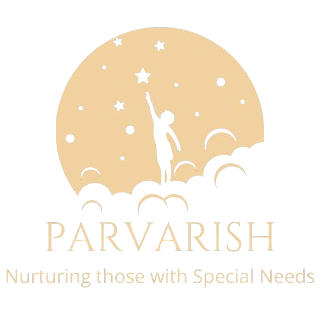
Speech and Language Therapy
Parents focus their main concern on their children's health through complete physical and psychological development. The parents show increased caution for all their children particularly toward those who are younger. When your child reaches 18 months old you need to examine how they talk along with their capacity to express needs through communication.
Such observations help children grow developmentally. If your child shows concerning speech and communication habits then seek qualified help to address their speech and language development needs. Parvarish as the leading speech and language therapy service provider in Delhi can tailor speech management solutions for your kids through their professional therapy services.
The Field of Speech and Language Therapy (SLT) operates as an essential care discipline.
SLT describes therapeutic support that helps children overcome their communication problems so they develop maximum speech effectiveness. The process requires understanding how these terms differ from one another while they are commonly mistyped.
Speech
When speaking generally about communication output parents and other adults use the word 'speech' to refer to both the content and clarity of messages.Children learn to distinction between different sounds when they hear phonemes. Improving the capacity for developing words begins with uniting sounds (lexicon creation).
Language
People commonly relate 'language' to various spoken components such as English along with Hindi and Tamil and Telugu. Speech and language therapists define the term language as both our communication content and our word construction methods.
Communication
In many different ways, we can use the word communication. It is commonly referred to in the broadest of manner as the way we relate to one another. But when speech and language therapists talk about communication, it refers more to Receptive and Expressive Language.
Who are speech and language therapists working with?

Speech and language therapists help people with a range of communication, eating or swallowing difficulties, and they do so with people of all ages. They help individuals between various stages in life, for different kinds of reasons (both short-lived and chronic) based on their need as mentioned below -
Babies and children
SLTs work with babies with feeding and swallowing difficulties.
- Neonatal care:They also support older children with:
- Autistic people
- Cleft palate: Dyslexia
- Deafness
- Dysfluency: Language delay
- Learning difficulties: Mild, moderate or severe Physical disabilities
- Selective mutism: Specific difficulties in producing sounds Stammering
- Voice disorders: Parvarish being the best and well-known speech therapy service provider, we treat many common speech disorders effectively. No matter how common speech disorders occur, we can treat all of them easily.
Speech therapy can help you improve your:
- Emergent Literacy Skills (particularly children learning to speak and communicate).
- Ability to use your voice
- Language skills (how well you understand words and language).
- Fluency (how well and easily you can use language).
- Clarity and expression
What does SLT involve?
Direct work with the client and offering support to the client and their care-givers is done by a Speech and Language Therapist. Parvarish therapists will work either one-on-one with a child, or in a small group, to help overcome challenges associated with a particular language disorder.
The therapy sessions will be different based on each child's set goals. That said, there are some key things you might encounter in a session:
- Sessions will start, middle and end
- Sessions may begin with a recap of the previous session
- Activities will be set up (typically play based)
- By engaging in the play based activities, the therapist will assist the child/children in attaining their goals in a number of ways.
- Concepts worked on will be reviewed along with goals for the session and homework with the parent at the end
Speech therapy can help you improve your:
- Emergent Literacy Skills (particularly children learning to speak and communicate).
- Ability to use your voice
- Language skills (how well you understand words and language).
- Fluency (how well and easily you can use language).
- Clarity and expression
What does SLT involve?
Direct work with the client and offering support to the client and their care-givers is done by a Speech and Language Therapist. Parvarish therapists will work either one-on-one with a child, or in a small group, to help overcome challenges associated with a particular language disorder.
The therapy sessions will be different based on each child's set goals. That said, there are some key things you might encounter in a session:
- Sessions will start, middle and end
- Sessions may begin with a recap of the previous session
- Activities will be set up (typically play based)
- By engaging in the play based activities, the therapist will assist the child/children in attaining their goals in a number of ways.
- Concepts worked on will be reviewed along with goals for the session and homework with the parent at the end.
What is the best age speech therapy?
Speech therapy can be beneficial for anyone who needs help with their speech or language skills. There is no best or more right age to seek help. Speech therapy for both young and adult patients can help anyone with communication disorder.
Research shows that children in need of speech therapy do best when the therapy starts early and with practice at home with a family member.
What activities are done in speech therapy?
For children speech therapy is usually presented in a playful manner, such as sequencing tasks or language-based board games.
For adults speech therapy typically focuses on the development or rehabilitation of specific skills, such as coordination between the brain and the mouth.
What are the advantages of speech therapy?
- Improved self-esteem
- Increased independence.
- Increased skills in reading and writing for self-expression or comprehension of ideas, thoughts and feelings.
- School readiness for young children.
- Enhanced vocal quality.
- Early language skills.
- Better swallowing function
- Improved quality of life
How long do you need speech therapy?
Everyone's needs are unique. Some speech disorders improve with age; others require years of speech therapy. If your speech disorder is caused by a medical condition, your speech and language skills may improve as you recover from the underlying issue
How long you need speech therapy depends on:
- Your age.
- The type of speech disorder.
- How severely the speech disorder affects your communication abilities.
- You need recovery from some pre-existing health issues.
- How often do you attend speech therapy?
